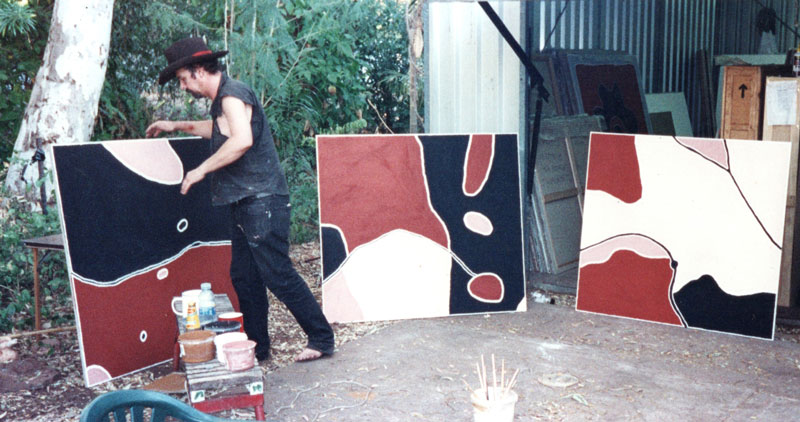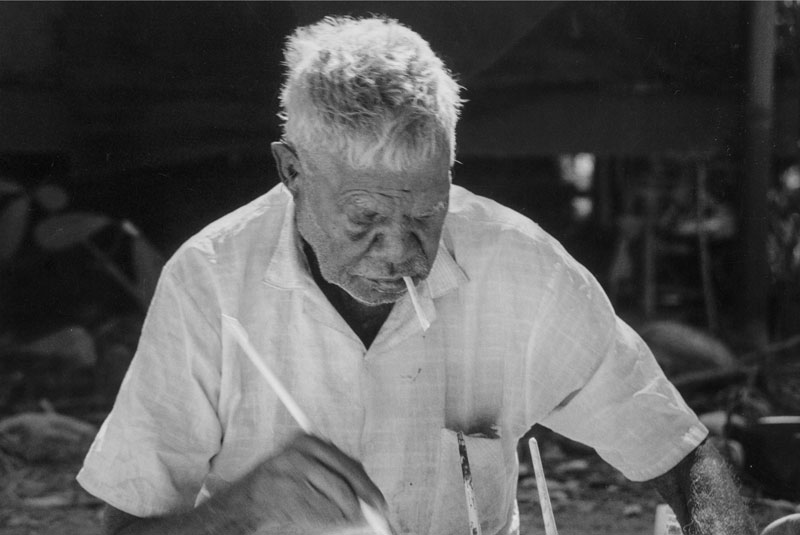.jpg)
Who is “The Stranger Artist”? The title of Quentin Sprague’s account of the artistic marvel that unfolded in the eastern Kimberley on either side of the new millennia evokes mystery. Focusing on the intervention of a single southern impresario, The Stranger Artist explores the impact of the artist and gallerist Tony Oliver on the work of a group of senior Gija-speaking artists who came together to form Jirrawun Arts in 1998. Sprague also worked at Jirrawun and takes us behind the earthy materiality of Gija art to reveal the intercultural relationships that underpin its creation. In particular, he describes the interactions between Indigenous artists with Oliver, their chosen interlocutor at improvised studios, in driveways, in the shade under stilt-houses and on the red earth of remote outstations.
Most significantly, Sprague’s account is informed by numerous discussions with Oliver, who was originally drawn to the Kimberley after a chance encounter with Gija man Freddie Timms in Melbourne in 1996. Sometimes costumed in a floor-length coat and black cowboy hat, Oliver emerges from the pages of Sprague’s tale to cut a swathe through the contemporary artworld. While in most circumstances, Oliver’s swashbuckling facade would be absurd, his association with the bold brushstrokes of the enigmatic ex-stockmen that he corralled on impressive canvases, and transported into the white cube for sell-out exhibitions, sanctioned the swagger.
The Stranger Artist is the book that Sprague wanted to write while undertaking a dissertation on black/white collaboration at the University of Wollongong. It is fortunate for the general reader that he had dispatched the required theoretical analysis before embarking on this journey, for The Stranger Artist is unencumbered by the academic parenthesis or screeds of rhetorical justification characteristic of a PhD thesis. Yet the rigours of earlier theoretical exertions buttress this visceral account of cultural interaction in Australia’s north. What results, is a gripping tale of Oliver’s hubris, the consequences of historic violence on an entire region, and glimpses of the redemptive possibilities of creative expression.
Oliver’s creative agency, and his capacity for self-justification, is cast against the scale of the land, its oppressive humidity and the inscrutable restraint of senior artists who know its cruel history. As narrator, Sprague is distanced from the action, a fly-on-the-wall who nonetheless guides us over blood-soaked massacre lands, hovers over transitional studios, and takes us into the cabin of a tray-back Land Cruiser as it careers out of control over a bridge between one world and the next. At the literary level, Sprague’s just-behind-the-scenes positioning enables the reader to appreciate events without encumbrance, through the lens of a writer who does not cast judgement on the conflicted world of Aboriginal arts production. Readers are shown the evidence, and are left to determine their own stance in relation to that contested territory.

The intercultural constitution of Aboriginal art is an arena primed for provocation, leading the Indigenous artist, Richard Bell to proclaim, “ABORIGINAL ART – it’s a white thing!” Others insist that traditionally-oriented elders, such as Emily Kame Kngwarreye or Paddy Bedford are inspired ciphers of deep Indigenous knowledge, their vision unsullied by a distant artworld and its machinations. Sprague maps the problematic terrain between the artificial poles of deterministic white intervention and untainted native expression. He acknowledges the value of artworks that can issue from the actions of an external catalyst, while remaining alert to the potential for perfidy.
Some employees of remote Aboriginal arts centres regard themselves as servants, employed by a community to bestow the conditions in which individual creativity can flourish. Other outsiders, including visiting artists actively collaborate to realise a shared vision. This model was championed by Tim Johnson and Imants Tillers during the heyday of post-modernism, and is still widely practiced as a means of reinvigorating local arts practice. Tony Oliver exemplifies yet another order of intervention, for he had the hutzpah to identify as a “creative director”, who, because of his exceptional talent could elicit the essential qualities of the Gija aesthetic from its practitioners, then deliver it in a form that corresponds to the desire of discerning cashed-up consumers. Tony Oliver is the “stranger artist” of the book’s title, who via his almost shamanistic superpowers delivers Gija art in its purest and reductively modernistic form.
My observations of other Aboriginal arts centres suggest that the “servant”, “collaborator” and “creative director” models can, and do operate successfully, to a greater or lesser extent, at any one time. But the exaggerated rise and fall of Jirrawun Arts exposes the risk of the unilateral adjudications of a creative director. Sprague traces the skyrocketing trajectory of Jirrawun, from inception to its zenith in July 2007, when the venerable star of the movement, Paddy Bedford, died. Oliver was by then exhausted and left the Kimberley. These two decisive events coincided with the initial portents of worldwide financial instability, and soon the Global Financial Crisis rocked markets in Europe and North America. Jirrawun imploded. Read in this broader sense, The Stranger Artist is a cautionary tale of a precious intercultural construction that crumbled, virtually unnoticed, as the world watched global stocks plummet.
Sprague’s account of the Jirrawun phenomenon is enhanced by the writer’s familiarity with the tropes of high-modernism, the semantic space into which Gija art was marketed. The link between the interventions of art advisors, who operate behind the scenes to produce the “minimalist look” in Aboriginal art, was originally recognised by the iconoclastic anthropologist Eric Michaels. In a provocatively titled essay, Bad Aboriginal Art (first published in Art and Text, 1988), Michaels wrote that, “Arts advisors can deny influencing indigenous art until they are mauve in the face”, arguing that over and above any suggestion by “word, look or gesture or price” the selection and supply of materials was the advisor’s determining responsibility.

Moreover, that their decisions had resulted “in the curiously schematic, minimal, Jules Olitski/Agnes Martinesque technique [of Papunya Tula art].” More than three decades later, Sprague lingers, intrigued by the tenuous alchemy of the Jirrawun studio in Wyndham. He describes how Tony Oliver “would first have to negotiate his own thick atmosphere of anxiety: excitement curdled with doubt.” Meanwhile Bedford, who would “rise before dawn, eat a meal of fried kidneys for breakfast and make his way next door to the studio. He’d sit smoking as Tony readied the first canvases for the day”. Sprague then evokes the moment as Oliver and Bedford “would be poised together over a work in progress … Tony looking and smiling, softly nodding his head, Paddy looking back, at times smiling too. Then the lines that reach out across the white field, the brushed infill that follows, the staggered dots that flag the work’s final stage.”
According to Sprague, “It was this closeness that set people talking. Paddy and Tony had been together near constantly since they had first met at Warmun, but with Paddy’s ever-rising profile had come newfound visibility. Not everybody liked what they saw.” It was the extent of their intersectional understanding (a quality essential to improvised music) that became contentious, especially when performed by on old black man and a younger white producer, on canvas for a lucrative market.
Oliver’s interventions can be regarded as an extension of cultural colonialism, that as Richard Bell has observed, “Like some voracious ancient God, Western Art devours all offerings at will.” Alternately, consumers may bask in diffused light reflected from the granular surface of Bedford’s canvases, unconcerned by the complex intercultural chemistry that drew them into existence. While divisive perceptions of the Oliver/Bedford collaboration are prevalent, The Stranger Artist takes us past polemics, or uncritical consumption, to observe Oliver’s modis operandi in place. “In the studio none of the gossip mattered. For Tony it was simple: Fuck them, he’d think. This is private.”
